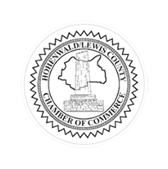![]() Turn left on East Second St. The large cedar tree on the left was present when the first settlers arrived. It served as the first community Christmas tree in the Swiss colony. Children lit candles to place on the tree on Christmas Eve as Hulda Muehlenthaler, dressed as an angel with white wings, dispensed oranges, nuts and applies to the children, an unusual treat for the time. The Swiss Reformed Church building was built to the right of the tree. Services were conducted in German. The building was also used as a school house for the Swiss children.
Turn left on East Second St. The large cedar tree on the left was present when the first settlers arrived. It served as the first community Christmas tree in the Swiss colony. Children lit candles to place on the tree on Christmas Eve as Hulda Muehlenthaler, dressed as an angel with white wings, dispensed oranges, nuts and applies to the children, an unusual treat for the time. The Swiss Reformed Church building was built to the right of the tree. Services were conducted in German. The building was also used as a school house for the Swiss children.
 11. Swiss Reformed Church Parsonage, 1902. 15 E. Second St.
11. Swiss Reformed Church Parsonage, 1902. 15 E. Second St.
Built to house the minister of the Swiss Reformed Church, the house features a bay window that was an unusual luxury for first generation houses. Emily Goemans remembers, "The Church had built a parsonage and they had one (minister) come over from Nashville, but it wasn't often enough -- the people wanted more than just Sunday school, which was every Sunday. So they asked my father to give talks to them. Later, he was ordained as a minister and we movved to town into the parsonage." Her father taught the school for the Swiss children. The house was closed in 1954 and remained boarded up for half a century.
12. Muechlenbach House, 1899. 114 South Maple St.
First owned by Frank Muechlenbach, a Swiss farmer, who likely built the house. The house was later home to 1912 Mayor Ed Johnson, who built about half the buildings in Hohenwald prior to 1914. Johnson then moved to Flagler Beach, Florida, where he helped create that town and was instrumental in construction of A!A highway from Saint Augustine to Daytona Beach. Other owners have included County Court Clerk Ernest Sprinkles and inventor Sam Bates, who built the first electrical power plant in town and who once built a Ferris wheel in the front yard for neighborhood children. During World War I, Bates and Cooper Allison invented a cluster bomb. When they sent to Chicago for a balloon to drop it and test it, investigators from the War Department showed up instead and confiscated the plans. Franklin Delano Roosevelt later sent Bates a person note of thanks for the contribution of his plans to the war effort. (The fish scaling trim on the eaves of this house was carved by hand.)
13. Keung HJouse, 1905. 18 East Second St.
Built by early town merchant Michael Keung, the house later served as home for Swiss carpenter August Schmidt, who likely made additions. Schmidt helped build several of the early houses in the town.



